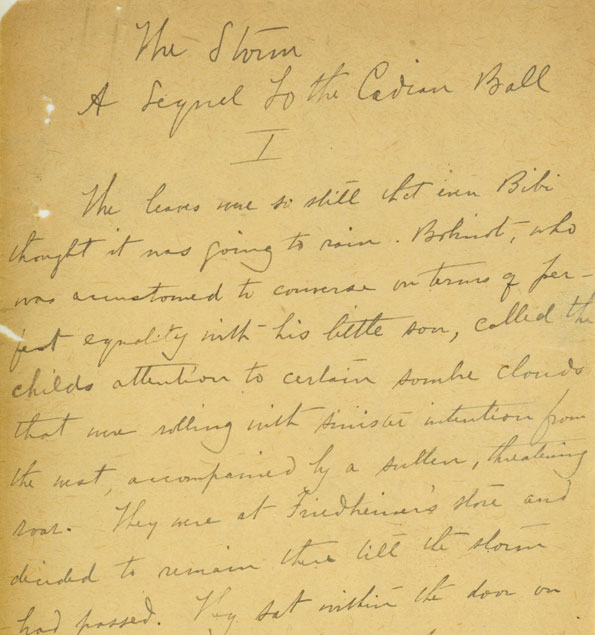Kate Chopin Archives: A Guide to Primary Documents
By Bonnie James Shaker
Kent State University at Geauga

Primary Source Archives
Although Kate Chopin’s fiction and private papers have been collected in reliable secondary sources, her original manuscripts, photographs, legal documents, correspondences, ephemera, and other primary source materials are preserved for continuing research in archives across the country. A large volume of this material has been digitized for online viewing.
Below are library repositories holding the greatest volume of Chopin’s original papers. Included are links to library websites, finding aids for off-site research, digitized records (where available), and procedures for visitors wishing to access collections on-site. Use and/or reproduction of this material should honor individual archives’ citation requests; the United States Copyright Act, including copyright status; and common citation standards.
Missouri Historical Society, St. Louis
The majority of Chopin’s extant primary source materials are held by the Missouri Historical Society. According to an archivist there, the entirety of Chopin’s holdings has been digitized.
Beyond the treasure trove of handwritten manuscripts, this collection also includes Chopin’s Account/Memo Books–ledgers of her fiction’s production, submission, rejection, or sale. Many scholars have traced Chopin’s self-professed “commercial instinct” to these books. Of them, Chopin scholar Barbara C. Ewell writes:
“Indeed, I am unaware of any comparable record by any other nineteenth-century writer. When I finally got to see and study and turn the pages of her account books myself, I was struck by their calculation and detail….This is one case where there is no real substitute for a facsimile” (Awakenings 39-40).
Researchers wishing to access the Chopin collection in person should consult guidelines on the Missouri History Museum website.
Northwestern State University of Louisiana Cammie G. Henry Research Center, Natchitoches
Located on the third floor of NSULA’s Watson Memorial Library in the parish Chopin once called home, the Cammie G. Henry Research Center contains unique holdings. In addition to a few Chopin family photographs, the center maintains some financial and death succession records of Oscar Chopin, Kate’s husband, as well as general historical material on the Cane River Region and its people. It also preserves inventory from the celebrated Kate Chopin Conferences held on the university campus from 1989-1995.
Visitors wishing to conduct long-distance and on-site research should consult guidelines on the research center website.
The Newberry Library, Chicago
The renowned Newberry Library’s vast materials in the humanities are relevant to virtually any writer of American letters, and this is no less true of Chopin. Its catalogs and collections, while dizzying in volume, are searchable online. Beyond secondary sources all conveniently housed in one place, The Newberry preserves a wealth of collections relevant to nineteenth-century American literary and publishing history, including copies of rare journals and the papers of Herbert S. Stone, publisher of The Awakening. According to Ewell, who made use of its collections, “The Newberry contained a fine cache of Chopin materials, including several publicity photographs that Chopin sent to her publisher to promote the novel” (Awakenings 38).
Researchers interested in accessing The Newberry’s collections should consult and adhere to the following guidelines on the library’s website.
Miscellaneous
Today, readers can view digital scans of many of Chopin’s published short stories, poems, essays, and letters in their original print form. They can also view prints of critics’ reviews of her fiction. These digital scans are preserved in (often) subscription-based, online databases of nineteenth-century American newspapers and periodicals. With the exception of the Digital Public Library of America, readers typically need access to subscribing university or research libraries to view the following:
Digital Public Library of America: Aggregates on one site many of the digital scans from institutional repositories across the United States. Researchers can find Kate Chopin resources. Anyone using the DPLA should carefully consult citation style guidelines for proper documentation of sources.
American Periodical Series Online: Among other publications, contains The Century Illustrated Magazine and the Youth’s Companion.
The Vogue Archive: Complete run from 1892.
Chronicling America: An open-access website of digitized historic American newspapers. Joint project of the National Endowment for the Humanities and the Library of Congress.
Kate Chopin Newsletter: Preserved in its original form at holding libraries; searchable via World Cat. Early Kate Chopin revival effort from the 1970s by editor and publisher, Emily Toth. Since collected in Regionalism and the Female Imagination.
The Archives Page of this website has been created by and is maintained by Bonnie James Shaker, Kent State University at Geauga, Ohio, USA. Professor Shaker is Associate Editor of KateChopin.org. Contact Bonnie Shaker.